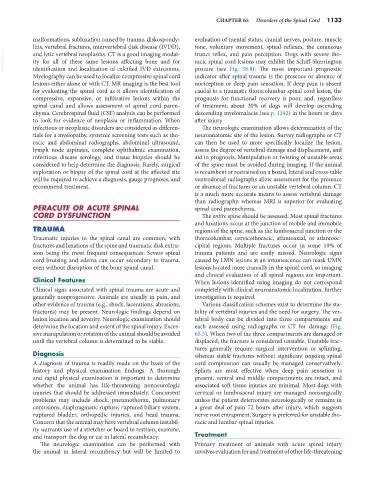Page 1161 - Small Animal Internal Medicine, 6th Edition
P. 1161
CHAPTER 65 Disorders of the Spinal Cord 1133
malformations, subluxation caused by trauma, diskospondy- evaluation of mental status, cranial nerves, posture, muscle
litis, vertebral fractures, intervertebral disk disease (IVDD), tone, voluntary movement, spinal reflexes, the cutaneous
VetBooks.ir and lytic vertebral neoplasms. CT is a good imaging modal- trunci reflex, and pain perception. Dogs with severe tho-
racic spinal cord lesions may exhibit the Schiff-Sherrington
ity for all of these same lesions affecting bone and for
identification and localization of calcified IVD extrusions.
indicator after spinal trauma is the presence or absence of
Myelography can be used to localize compressive spinal cord posture (see Fig. 58.8). The most important prognostic
lesions either alone or with CT. MR imaging is the best tool nociception or deep pain sensation. If deep pain is absent
for evaluating the spinal cord as it allows identification of caudal to a traumatic thoracolumbar spinal cord lesion, the
compressive, expansive, or infiltrative lesions within the prognosis for functional recovery is poor, and, regardless
spinal canal and allows assessment of spinal cord paren- of treatment, about 20% of dogs will develop ascending
chyma. Cerebrospinal fluid (CSF) analysis can be performed descending myelomalacia (see p. 1142) in the hours or days
to look for evidence of neoplasia or inflammation. When after injury.
infectious or neoplastic disorders are considered as differen- The neurologic examination allows determination of the
tials for a myelopathy, systemic screening tests such as tho- neuroanatomic site of the lesion. Survey radiographs or CT
racic and abdominal radiographs, abdominal ultrasound, can then be used to more specifically localize the lesion,
lymph node aspirates, complete ophthalmic examination, assess the degree of vertebral damage and displacement, and
infectious disease serology, and tissue biopsies should be aid in prognosis. Manipulation or twisting of unstable areas
considered to help determine the diagnosis. Rarely, surgical of the spine must be avoided during imaging. If the animal
exploration or biopsy of the spinal cord at the affected site is recumbent or restrained on a board, lateral and cross-table
will be required to achieve a diagnosis, gauge prognosis, and ventrodorsal radiographs allow assessment for the presence
recommend treatment. or absence of fractures or an unstable vertebral column. CT
is a much more accurate means to assess vertebral damage
than radiography, whereas MRI is superior for evaluating
PERACUTE OR ACUTE SPINAL spinal cord parenchyma.
CORD DYSFUNCTION The entire spine should be assessed. Most spinal fractures
and luxations occur at the junction of mobile and immobile
TRAUMA regions of the spine, such as the lumbosacral junction or the
Traumatic injuries to the spinal canal are common, with thoracolumbar, cervicothoracic, atlantoaxial, or atlantooc-
fractures and luxations of the spine and traumatic disk extru- cipital regions. Multiple fractures occur in some 10% of
sion being the most frequent consequences. Severe spinal trauma patients and are easily missed. Neurologic signs
cord bruising and edema can occur secondary to trauma, caused by LMN lesions at an intumescence can mask UMN
even without disruption of the bony spinal canal. lesions located more cranially in the spinal cord, so imaging
and clinical evaluation of all spinal regions are important.
Clinical Features When lesions identified using imaging do not correspond
Clinical signs associated with spinal trauma are acute and completely with clinical neuroanatomic localization, further
generally nonprogressive. Animals are usually in pain, and investigation is required.
other evidence of trauma (e.g., shock, lacerations, abrasions, Various classification schemes exist to determine the sta-
fractures) may be present. Neurologic findings depend on bility of vertebral injuries and the need for surgery. The ver-
lesion location and severity. Neurologic examination should tebral body can be divided into three compartments and
determine the location and extent of the spinal injury. Exces- each assessed using radiographs or CT for damage (Fig.
sive manipulation or rotation of the animal should be avoided 65.3). When two of the three compartments are damaged or
until the vertebral column is determined to be stable. displaced, the fracture is considered unstable. Unstable frac-
tures generally require surgical intervention or splinting,
Diagnosis whereas stable fractures without significant ongoing spinal
A diagnosis of trauma is readily made on the basis of the cord compression can usually be managed conservatively.
history and physical examination findings. A thorough Splints are most effective when deep pain sensation is
and rapid physical examination is important to determine present, ventral and middle compartments are intact, and
whether the animal has life-threatening nonneurologic associated soft tissue injuries are minimal. Most dogs with
injuries that should be addressed immediately. Concurrent cervical or lumbosacral injury are managed nonsurgically
problems may include shock, pneumothorax, pulmonary unless the patient deteriorates neurologically or remains in
contusions, diaphragmatic rupture, ruptured biliary system, a great deal of pain 72 hours after injury, which suggests
ruptured bladder, orthopedic injuries, and head trauma. nerve root entrapment. Surgery is preferred for unstable tho-
Concern that the animal may have vertebral column instabil- racic and lumbar spinal injuries.
ity warrants use of a stretcher or board to restrain, examine,
and transport the dog or cat in lateral recumbency. Treatment
The neurologic examination can be performed with Primary treatment of animals with acute spinal injury
the animal in lateral recumbency but will be limited to involves evaluation for and treatment of other life-threatening

